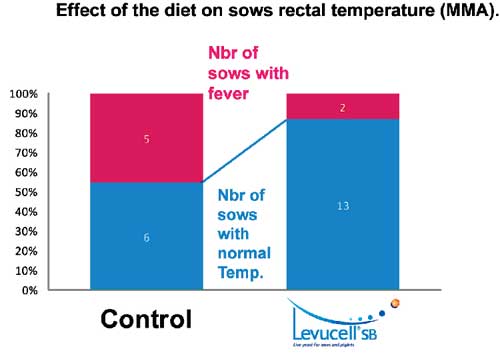Live yeast reduces incidence of MMA in at-risk pig farms

Two new studies look at the link between mild Mastitis Metritis Agalactia(neonatal diarrhoea)and digestive bacterial endotoxins.
Recently, endotoxins have attracted the attention of animal nutritionists but little research is still done on their effects on sows.
Lallemand Animal Nutrition has conducted a research project on the potential role of digestive endotoxin on postpartum dysgalaxia syndrome, a mild form of Mastitis Metritis Agalactia (MMA), and neonatal diarrhoea.
This project also looked at the possible effect of live yeast (Levucell SB) in sow diet on the reduction of mild MMA incidence by securing the digestive process.
On June 1st the results of two studies were shown for the first time at the 12th International Symposium on Digestive Physiology in Pigs, in Keystone, Colorado, USA, the premier event dedicated to pigs digestive physiology. The presentation was part of the session: Long term effects of pre and early postnatal nutrition/environment.
Relationship between digestive endotoxins and PDS
In sows, the release of endotoxins in the digestive tract has been suggested to play a role in MMA.
Field observations indicate that live yeast supplementation in peri-partal sows could reduce the incidence of MMA.
In order to verify this additional benefit of S. boulardii yeast and gain a better understanding of the onset of MMA and its link with digestive endotoxin, a trial was conducted in a farm with chronic MMA incidence for two previous years.
All sows farrowing in May and June were put on trial, full data could be collected for 26 sows only: 11 control, 15 receiving live yeast (S. cerevisiae boulardii CNCM-I 1079) at the rate of 2×109 CFU/kg feed.
Results
First of all, this study showed a good relationship between colostrum endotoxin levels and clinical signs of MMA (fever of sow and neonatal diarrhoeas in piglets).
Live yeast had a positive effect on the incidence of MMA in this high-risk farm.
There was a positive correlation between plasmatic and colostral endotoxin.
This study supports that endotoxin derived from intestinal bacteria could be linked to the development of MMA. However, the low number of sows studied did not allow drawing firm conclusions about the effect of the live yeast on endotoxin transfer and further studies should be conducted with larger number of animals.
Mother – piglet pass on
The second study presented at Keystone’s Symposium looked further at the effect of sow’s endotoxin on the piglet: endotoxin transfer through colostrum from the dam to the piglet.
Indeed, it has been observed that neonatal diarrhoea is common in farms with high incidence of MMA, especially in litters from young sows, and it has been suggested that these diarrhoeas could be linked to the transfer of endotoxin from the sow to the piglet through the colostrum.
Second trial
In this trial, seven litters from sows in parity 1 or 2 were studied, none of which were affected by neonatal diarrhoea.
Endotoxin levels were assessed from the colostrum sampled during the farrowing process, and from piglets’ blood sampled at 24h of life.
First of all, this trial showed overall low levels of endotoxin contamination in colostrum (between 12 and 27 ng/mL).
Furthermore, a huge variability was observed between piglets of the same litter, which might reflect individual differences in colostrum intake, blood volume, or gut permeability.
A positive correlation was found between colostrum contamination and piglets blood endotoxin contents (+0.35).
It was concluded that these results indicate a transfer of endotoxin from the dam to the piglet through the colostrum.
In order to verify the initial hypothesis, animals studies in which the range of endotoxin concentration in colostrum would be greater would be necessary.
What are endotoxins?
Endotoxins are toxins of bacterial origin. They mainly refer to lipopolysaccharide (LPS), a major constituent of the outer cell wall of Gram-negative bacteria. They differ for every pathogenic bacteria and determine their serotype.
Their toxic effect also differs and is principally linked to their specific interactions with certain cells of the immune system (presence of specific receptors), which triggers the production of a broad spectrum of immune mediators such as cytokines, nitric oxide, etc. Endotoxins are in large part responsible for the clinical manifestations of infections with pathogenic bacteria.
Studies cited:
- D. Guillou, V. Demey , F. Chaucheyras-Durand and Y. Le Treut, Relationship between gut-derived endotoxin and postpartum dysgalaxia syndrome in sows.
- D. Guillou, S.Isinger, F. Chaucheyras-Durand and Y. Le Treut. Endotoxin transfer through colostrum from the dam to the piglet.
Both studies were presented at the 12th International Symposium on Digestive Physiology in Pigs, May 29-June 1st 2012.
Join 26,000+ subscribers
Subscribe to our newsletter to stay updated about all the need-to-know content in the feed sector, three times a week. Beheer
Beheer









 WP Admin
WP Admin  Bewerk bericht
Bewerk bericht